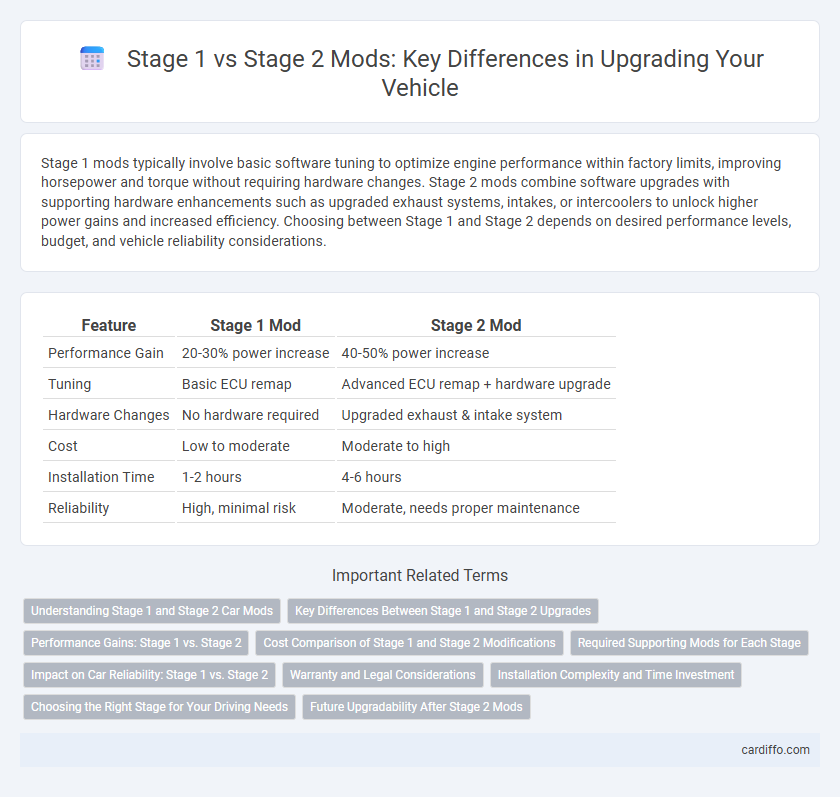Stage 1 mods typically involve basic software tuning to optimize engine performance within factory limits, improving horsepower and torque without requiring hardware changes. Stage 2 mods combine software upgrades with supporting hardware enhancements such as upgraded exhaust systems, intakes, or intercoolers to unlock higher power gains and increased efficiency. Choosing between Stage 1 and Stage 2 depends on desired performance levels, budget, and vehicle reliability considerations.
Table of Comparison
| Feature | Stage 1 Mod | Stage 2 Mod |
|---|---|---|
| Performance Gain | 20-30% power increase | 40-50% power increase |
| Tuning | Basic ECU remap | Advanced ECU remap + hardware upgrade |
| Hardware Changes | No hardware required | Upgraded exhaust & intake system |
| Cost | Low to moderate | Moderate to high |
| Installation Time | 1-2 hours | 4-6 hours |
| Reliability | High, minimal risk | Moderate, needs proper maintenance |
Understanding Stage 1 and Stage 2 Car Mods
Stage 1 car mods typically involve basic ECU tuning and bolt-on components like intake and exhaust systems that increase horsepower and torque without requiring extensive hardware changes. Stage 2 modifications build upon Stage 1 by adding more aggressive parts such as upgraded turbochargers, intercoolers, and high-flow fuel injectors, delivering significantly higher performance gains. Understanding the distinction between Stage 1 and Stage 2 helps optimize vehicle upgrades by balancing cost, reliability, and power output for tailored driving experiences.
Key Differences Between Stage 1 and Stage 2 Upgrades
Stage 1 upgrades primarily focus on optimizing the engine's air intake and exhaust systems, delivering moderate horsepower gains without requiring major hardware changes. Stage 2 modifications involve more extensive enhancements, including upgraded turbochargers, intercoolers, and fuel systems, resulting in significantly higher performance increases but often necessitating advanced tuning and supporting upgrades. The key difference lies in the scope and complexity of modifications, with Stage 1 providing a reliable power boost and Stage 2 pushing the engine towards maximum output potential.
Performance Gains: Stage 1 vs. Stage 2
Stage 1 mods typically deliver moderate performance gains by optimizing air intake and ECU tuning, increasing horsepower and torque without requiring hardware changes. Stage 2 mods enhance performance more significantly by incorporating upgraded components such as high-flow exhaust systems and intercoolers, enabling the ECU to maximize power output and reliability. The difference in gains between Stage 1 and Stage 2 can range from 10-20% horsepower increase, with Stage 2 providing a more aggressive and sustained performance boost.
Cost Comparison of Stage 1 and Stage 2 Modifications
Stage 1 modifications typically cost between $300 and $1,000, focusing on basic upgrades like intake, exhaust, and ECU tuning to enhance performance without extensive hardware changes. Stage 2 mods generally range from $1,000 to $3,000, involving more significant enhancements such as upgraded turbochargers, intercoolers, and fuel systems to deliver higher power gains. The cost difference reflects the complexity and parts required, making Stage 2 a more expensive but substantial performance investment compared to Stage 1.
Required Supporting Mods for Each Stage
Stage 1 mods typically require basic supporting upgrades such as high-flow air filters and upgraded exhaust systems to optimize airflow and improve engine efficiency. Stage 2 mods demand more comprehensive supporting modifications, including intercoolers, upgraded fuel injectors, and enhanced engine management systems to handle increased power output and maintain reliability. Proper supporting components ensure each stage achieves maximum performance gains without compromising engine durability.
Impact on Car Reliability: Stage 1 vs. Stage 2
Stage 1 mods generally improve car performance with minimal impact on reliability due to their reliance on basic ECU remapping and bolt-on parts that maintain factory tolerances. Stage 2 modifications involve more aggressive tuning and hardware changes like upgraded turbochargers, often pushing components closer to their limits, which can decrease overall reliability if not managed properly. Choosing between Stage 1 and Stage 2 should consider the balance between desired power gains and the potential strain on engine and drivetrain longevity.
Warranty and Legal Considerations
Stage 1 mods typically involve minor engine tuning and bolt-on parts that maintain manufacturer warranty and comply with emission regulations, posing minimal legal risks. Stage 2 upgrades demand extensive hardware changes like upgraded turbochargers or exhaust systems, often voiding warranties and risking non-compliance with local emission laws. Vehicle owners should carefully review warranty terms and local regulations before opting for Stage 2 modifications.
Installation Complexity and Time Investment
Stage 1 mods typically involve straightforward installation processes, often requiring basic tools and limited mechanical knowledge, making them ideal for beginners or those seeking quick performance gains. In contrast, Stage 2 modifications demand more advanced technical skills, specialized tools, and longer installation times due to additional components and tuning requirements. The increased complexity and time investment of Stage 2 upgrades reflect their potential for higher performance enhancements compared to Stage 1.
Choosing the Right Stage for Your Driving Needs
Stage 1 mods offer basic performance enhancements with minimal engine or ECU changes, ideal for daily drivers seeking improved throttle response and mild power gains without compromising reliability. Stage 2 modifications involve more extensive upgrades, including upgraded turbochargers, exhaust systems, and intercoolers, suited for enthusiasts wanting significant horsepower increases and track-capable performance. Selecting between Stage 1 and Stage 2 depends on your driving goals, vehicle usage, and budget, ensuring the mod stage aligns with your need for power, reliability, and compliance with emissions regulations.
Future Upgradability After Stage 2 Mods
Stage 1 mods typically enhance basic engine performance without requiring major hardware changes, preserving most factory components for easy future upgrades. Stage 2 mods involve more extensive modifications such as upgraded turbochargers or intercoolers, which may limit the scope of future enhancements due to increased stress on the drivetrain and engine components. After Stage 2, careful consideration is essential as future upgrades often demand reinforced internals or complete system overhauls to maintain reliability and performance gains.
Stage 1 vs Stage 2 Mods Infographic

 cardiffo.com
cardiffo.com